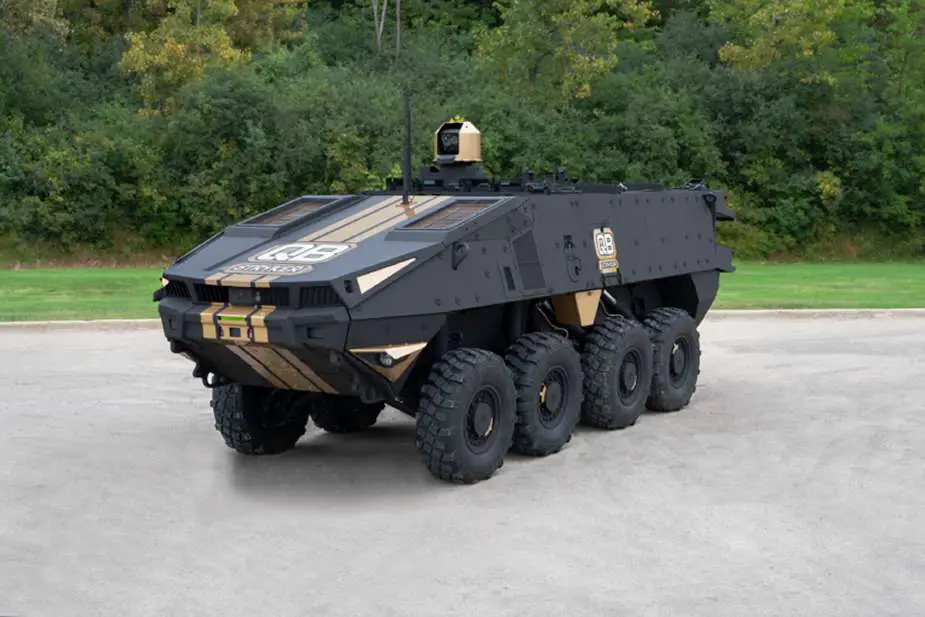Breaking news
GDLS to unveil StrykerQB robotic vehicle at AUSA 2023.
During an interview with Defense Daily on October 4, 2023, Scott Taylor, Director of US Business Development at General Dynamics Land Systems (GDLS), mentioned that the company is preparing to unveil the StrykerQB technology demonstrator at the Association of the United States Army's (AUSA) annual conference in Washington, D.C. This hybrid-electric platform has been designed to serve as a robotic controller vehicle, with insights gathered from the US Army and their ongoing human-machine integration initiative.
Follow Army Recognition on Google News at this link

General Dynamics Land Systems to unveil its new hybrid StrykerQB robotic vehicle at AUSA 2023 (Picture source: GDLS)
GDLS had previously introduced the StrykerX 8x8 APC and AbramsX tank demonstrators at AUSA 2022. These prototypes weren't mere showcases but aimed to demonstrate capabilities that might potentially be integrated into existing military fleets or future combat vehicle programs, thus partly influencing the development of the StrykerQB.
The inspiration for StrykerQB's development can be traced to the ongoing Robotic Combat Vehicle (RCV) initiative of the US Army, which seeks to assess the viability of deploying robotic vehicles in combat operations. In a recent development, GDLS' Tracked Robot X-Ton (TRX) was selected by the Army for the initial phase of its RCV competition, alongside companies such as Textron Systems and Oshkosh Defense. Each of these companies has been tasked with delivering two prototype platforms. Taylor indicated that the Army might not be immediately prepared to allocate significant resources for a robotic controller vehicle. However, the US company remains open to the possibility of StrykerQB being involved in experimentation within the broader context of the Army's human-machine integration initiative.
One noteworthy aspect of StrykerQB is its Safran-built sight capability, seamlessly integrated into the platform to enhance situational awareness when operating robotic platforms in various field conditions. Taylor emphasized that the large screen terminals located at the rear of the vehicle can effectively utilize any of the sights mounted on the vehicle or integrate them into the vehicle's comprehensive 360-degree situational awareness system.
Comparing the StrykerQB to its predecessor, the StrykerX, Taylor highlighted significant enhancements, including increased size, weight, and power capabilities aimed at facilitating multi-robotic control. Additionally, the StrykerQB features improvements in safety, functionality, and situational awareness, which enable a comprehensive 360-degree view of its surroundings, a critical factor in complex combat scenarios.
The StrykerX, introduced as a technology demonstrator last year, differs from the Stryker 8x8 armored vehicles. Its development aimed to showcase GDLS's capabilities in reducing vehicle emissions and fuel consumption, aligning with the evolving requirements of the US armed forces. The StrykerX features a completely redesigned layout, with the driver and commander seated side by side to improve communication and provide the commander with the option to assume control if necessary. This differs from the standard configuration of the Stryker, where the driver is positioned at the front left side of the hull, with the vehicle commander located behind. The front of the StrykerX is equipped with two hatches.
The rear portion of the StrykerX has undergone modifications to offer more spacious and comfortable accommodations for troops. The vehicle includes an integrated Active Protection System and advanced electronic architecture with cyber defense for enhanced troop protection. To enhance observation capabilities, the vehicle's roof can be utilized to carry a drone, allowing for reconnaissance missions conducted by troops from within the vehicle, safely shielded by armor. StrykerX is equipped with an array of sensors providing its occupants with 360-degree situational awareness and see-through armor capability.
Regarding mobility, the GDLS StrykerX technology demonstrator is powered by a hybrid diesel-electric power pack, aligning with the US Army's climate and electrification strategies. The StrykerX technology demonstrator introduces capabilities to the Stryker family, including silent movement, silent watch, exportable electric power, and reduced fuel consumption through its hybrid diesel-electric power pack.

Compared to its predecessor (StrykerX), the StrykerQB includes significant enhancements aimed at facilitating multi-robotic control (Picture source: Army Recognition)


























